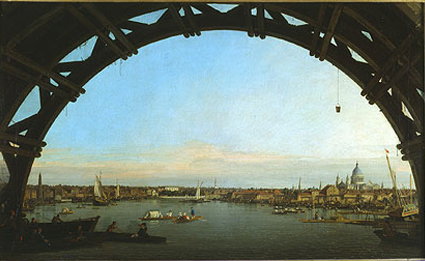Andrew Graham-Dixon reveals a visionary blend of the English and the Italianate in 'Canaletto and England'
In 1746 Antonio Canaletto came to London from Venice and many of the pictures he painted during the nine years he spent in the capital suggest an artist uneasily acclimatising himself to new surroundings. London Seen Through an Arch of Westminster Bridge, one of the most instantly memorable pictures in ''Canaletto and England'', at the Gas Hall in Birmingham, is a case in point: a painting of one city (London) so suffused with memories of another (Venice) that it represents neither, but rather a fantastical hybrid of the two. The result is deeply ambiguous, stranding anyone who looks at the picture in a place, neither entirely Italian nor entirely English, that seems suspended between fantasy and reality.
The great curving arch of a bridge frames the prospect of a busy metropolitan river alive with commercial activity. The right- hand river bank is dominated by a single landmark, the vast proud dome of a great church towering over the other buildings. But where are you, exactly? The bridge is said to be Westminster Bridge but it could be the Rialto; the river is the Thames but it could be the Grand Canal; the church is Wren's St Paul's but it could be Palladio's San Giorgio Maggiore. The sense of double- take even extends to the blue, blue sky, which looks as if it has been imported from Italy to England for the day.
Canaletto's father was a stage scenery painter and Canaletto would always treat topography with a certain degree of theatrical licence. He saw buildings as stage flats and often rearranged them at will, moving churches this way and that, modifying skylines and relocating monuments to serve his own purposes.
Owen McSwiney, the theatrical...


